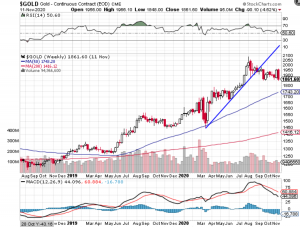Why cycles are useful as a risk management tool…
Cycle theory is a risk management tool for helping to time optimal buy points in a bull market. It is not very useful for timing sales. The reason for this is that cycles are measured from trough to trough.
For “intermediate” cycles, one references the weekly chart. The troughs are established by “swing lows” (google the term if you are not sure what that is). Cycle theory is based on empirical cycle lengths. For gold, on average, I would say its cycles are anywhere from 24-30 weeks. In a trending bull market, each intermediate cycle low will establish a higher low.
Gold’s last intermediate cycle low came the week of March 16th. The cycle peak (marked by a swing high) came on week 20 (as measured from the March 16th low). One tool that cyclists use to determine whether the cycle has truly peaked and is in decline is to see if the trendline established since the last ICL is broken. In the chart below you can see that the blue trendline was clearly broken in August, confirming that the swing high on week 20 was in fact the cycle peak.
Once the trendline was broken, and knowing that gold cycles last 24-30 weeks on average, you can then try to time your next buy. A strict cyclist would wait for a weekly swing low between week 24-30 of the cycle to get long.
As of today (34 weeks into the intermediate cycle), however, $gold has still not made a weekly swing low, so a pure cyclist would not be buying $gold yet. He would wait for a weekly swing low and THEN get long. One important tool that can be used to confirm that the cycle low is in is that the downtrend line established from the cycle peak will be broken. But we do not even have a weekly swing low yet, so that does not come into play yet.
Cycles are not a perfect timing tool for timing buys in a bull market. It is a tool for managing risk and nothing more. That being said, the next weekly swing low in $gold has a VERY high probability of marking the intermediate cycle low since the cycle is already 34 weeks long. By definition, a strict cyclist will never ever buy the EXACT low, since a swing low has to be established first. Once a swing low is established, if he wants, the cyclist can set the swing low as his stop loss.
Again, is it foolproof? No, but it is far better (i.e., lower risk) to be buying the next weekly swing low than blindly buying on say week 20 or 21 when $gold was $2000+. This is especially true if you are using margin and run the risk of a margin call if you “bought high,” even if you are ultimately right about the long term trend.
(One final note: I am NOT a strict cyclist, as I added to my positions on September 24th, taking a gamble that that would be the cycle low–that gamble was clearly wrong, but a strict cyclist would have never taken that bet for the reasons outlined above.)

So we are 4 weeks past a normal Gold Cycle ?
Which trend line needs to break before you see this as an ICL ?
Tnaks for the Tutorial Nautilus
Yes we are a few weeks over the typical IC length. However, in the last 2 years, there was a cycle that lasted 36 weeks.
As far as a trendline to confirm an ICL, I really only feel this will be useful once we get a weekly swing low, which we still don’t have. You can draw the downtrend line from the August high and try to hit at least one midcyle peak as well, but there is a huge fudgefactor on where the best line is. Last week’s candle fooled a lot of non-strict cyclists because it appeared to break the downtrend line (or should I say “a” downtrend line), but the problem is we never got a swing low on the weekly chart to confirm September 24th as the absolute low in the first place. That was putting the cart before the horse, and premature cyclists paid the price for that greed/FOMO this week.
I should also add that every day that goes by the risk for shorts goes up, since we are undoubtedly extremely close to an intermediate cycle low.
The problem for anyone getting long ahead of a confirmed weekly swing low though, is that gold might just decide to drop a lot lower in the next 2 weeks–maybe $100 or more potentially, especially given the size of this week’s massive drop and the fact that the 200 dma/50WMA is a very common target for gold at intermediate cycle lows.
These are extremely well reasoned posts and are much appreciated. I hope you to continue to post often.
Also a hands off to Surf and Norvast for their contributions in cycle analysis as well.